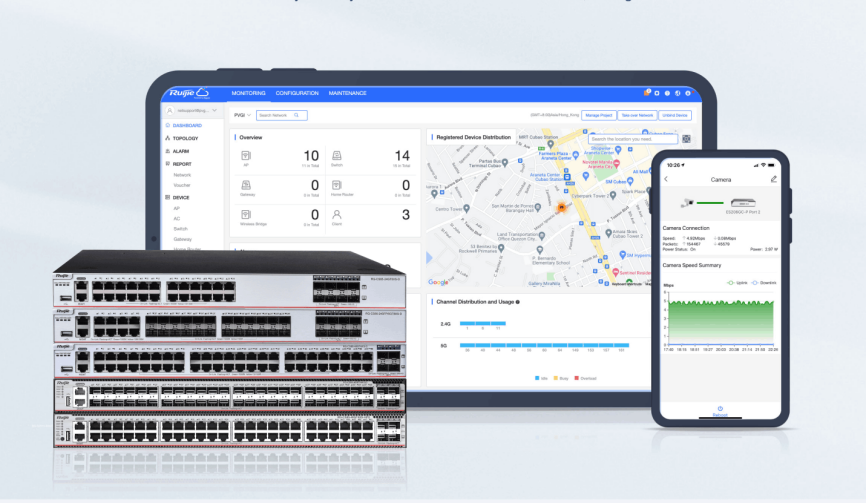Layer 3 Switch, also known as a three-layer switch, is a network device that combines the functions of traditional routers and layer 2 switches, playing a key role in modern network architecture.
Understanding the Layer 3 Switch Concept
Layer 3 Switch operates at the third layer of the OSI model, namely the network layer. It can not only efficiently process layer 2 packets like a layer 2 switch but also process layer 3 packets like a router. This makes Layer 3 Switches widely used in data centers, large enterprise networks, and scenarios that require high-performance and efficient packet forwarding.

Working Principle of Layer 3 Switch
Layer 3 Switch forwards packets mainly through the following two methods:
MAC address-based forwarding: When a Layer 3 Switch receives a packet, it first checks the destination MAC address of the packet. If the address is in its MAC address table, it directly forwards the packet to the corresponding port. Otherwise, it broadcasts the packet to all ports until the destination MAC address is found. This method is applicable to device communication within the same local area network (LAN).
IP address-based forwarding: For packets that need to be transmitted across networks, Layer 3 Switch examines the IP header information and forwards based on the destination IP address and its own routing table. This process is similar to how traditional routers work, but because Layer 3 Switch implements this function in hardware, its forwarding speed is faster. This method is applicable to communication between different subnets or networks.
Layer 3 Switch Core Functions
Inter-VLAN routing: Layer 3 Switch can route between different VLANs without the need for an external router, which greatly improves network efficiency.
Support for routing protocols: Layer 3 Switch supports common routing protocols such as OSPF (Open Shortest Path First), EIGRP (Enhanced Interior Gateway Routing Protocol), BGP (Border Gateway Protocol), etc. These protocols allow network devices to adjust routing paths according to dynamically changing network environments, improving network reliability and scalability.
High performance: Layer 3 Switch uses dedicated hardware for high-speed packet forwarding, typically with low latency and high throughput, making it very suitable for large enterprise and data center networks.
Security: Layer 3 Switch supports access control lists (ACL), firewall functions, port security, etc., enhancing network security.
Traffic management: Through VLAN segmentation and routing control, Layer 3 Switch can implement more complex network policies and traffic management, reduce broadcast storms, and optimize network performance.
Layer 3 Switch Application Scenarios
Enterprise networks: In large enterprises, multiple departments are usually divided into different VLANs. Layer 3 Switch can efficiently manage and route communications between these VLANs, ensuring network efficiency and security.
Data centers: Data centers need to handle large amounts of internal traffic and complex routing requirements. Layer 3 Switch, with its high performance and ability to support multiple routing protocols, becomes the core device of data center networks.
Campus networks: School and university campus networks typically involve multiple buildings and a large number of users. Layer 3 Switch can effectively manage network traffic in different areas, providing stable network connections.

Overall, we can understand that a Layer 3 Switch is a powerful and flexible network device that combines the advantages of routers and layer 2 switches, providing high-performance and efficient packet forwarding. However, when designing and deploying networks, appropriate devices should be selected based on specific requirements and environments.

RG-CS85-48GT4XS-HPD 48-Port GE Electrical Layer 3 Enterprise-Class PoE Core or Aggregation Switch, 4 × 10G Uplink Ports
Of course, with sufficient budget, choosing quality manufacturers like Ruijie Reyee can save a lot of trouble. The Layer 3 Switch products provided by Ruijie Reyee not only have rich port types, but their configuration schemes can be more flexible and effective. In formal deployment, they also actively consider functional requirements such as hardware redundancy, VSU virtualization, network security policies, real-time monitoring, and log backup to comprehensively enhance network flexibility and reliability, ensure stable and efficient data transmission, while simplifying subsequent network maintenance and implementing solutions with higher usability.
Featured Articles
- Networking Tools for Retail Stores: The Core Value of Cloud-Managed APs












